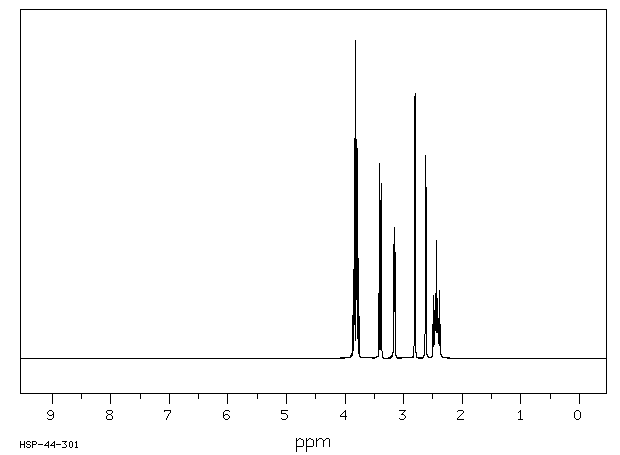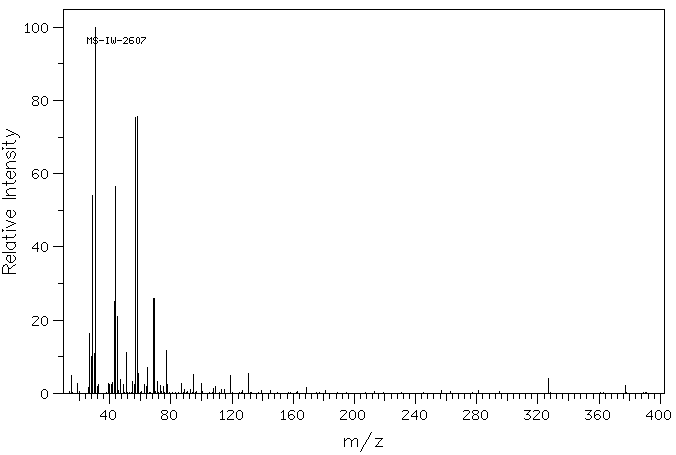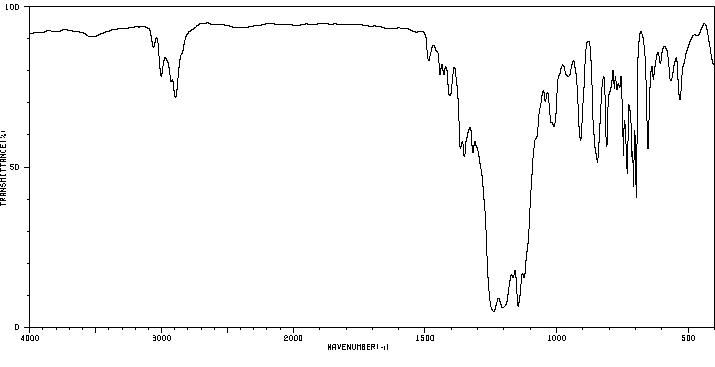3-[(2-全氟己基)乙氧基]-1,2-环氧丙烷 | 122193-68-4
中文名称
3-[(2-全氟己基)乙氧基]-1,2-环氧丙烷
中文别名
3-(3,3,4,4,5,5,6,6,7,7,8,8,8-十三氟辛氧基)-1,2-环氧丙烷;3-[2-(五氟己烷基)乙氧基]-1,2-环乙氧基丙烷;3-(2-全氟己基乙氧基)-1,2-环氧丙烷;3-(3,3,4,4,5,5,6,6,7,7,8,8,8-三十氟辛氧基)-1,2-环氧丙烷
英文名称
3-[2-(tridecafluorohexyl)ethoxy]-1,2-epoxypropane
英文别名
perfluorohexylethyl glycidyl ether;2-(3,3,4,4,5,5,6,6,7,7,8,8,8-tridecafluorooctoxymethyl)oxirane
CAS
122193-68-4
化学式
C11H9F13O2
mdl
——
分子量
420.17
InChiKey
DRSDQADBHIDJCU-UHFFFAOYSA-N
BEILSTEIN
——
EINECS
——
-
物化性质
-
计算性质
-
ADMET
-
安全信息
-
SDS
-
制备方法与用途
-
上下游信息
-
文献信息
-
表征谱图
-
同类化合物
-
相关功能分类
-
相关结构分类
物化性质
-
沸点:218.8±40.0 °C(Predicted)
-
密度:1.57
计算性质
-
辛醇/水分配系数(LogP):4.6
-
重原子数:26
-
可旋转键数:9
-
环数:1.0
-
sp3杂化的碳原子比例:1.0
-
拓扑面积:21.8
-
氢给体数:0
-
氢受体数:15
安全信息
-
海关编码:2910900090
SDS
Section I.Chemical Product and Company Identification
Chemical Name 3-[2-(Perfluorohexyl)ethoxy]-1,2-epoxypropane
Portland OR
Synonym
Oxirane, [[(3,3,4,4,5,5,6,6,7,7,8,8,8-
tridecafluorooctyl)oxy]methyl]- (9 CI)
Chemical Formula
C 11 H 9 F 13 O 2
CAS Number
122193-68-4
(International)
Section II. Composition and Information on Ingredients
Chemical Name CAS Number Percent (%) TLV/PEL Toxicology Data
3-[2-(Perfluorohexyl)ethoxy]-1,2-epoxypropane 122193-68-4 Min. 96.0 (GC) Not available. Not available.
Section III. Hazards Identification
Acute Health Effects
N o specific inform ation is available in our data base regarding the toxic effects of this m aterial for hum ans. H ow ever,
exposure to any chem ical should be kept to a m inim u m . Skin and eye contact m ay result in irritation. M ay be harm ful if
inhaled or ingested. A lw ays follow safe industrial hygiene practices and w ear proper protective equipm ent w hen
handling this compound.
Follow safe industrial hygiene practices and always wear proper protective equipment when handling this compound.
Chronic Health Effects
CARCINOGENIC EFFECTS : Not available.
MUTAGENIC EFFECTS : Not available.
TERATOGENIC EFFECTS : Not available.
DEVELOPMENTAL TOXICITY : Not available.
Repeated or prolonged exposure to this compound is not known to aggravate existing medical conditions.
Section IV. First Aid Measures
Eye Contact
C heck for and rem ove any contact lenses. In case of contact, im m ediately flush eyes w ith plenty of w ater for at least 15
minutes. Get medical attention.
Skin Contact
In case of contact, im m ediately flush skin w ith plenty of w ater. Rem ove contam inated clothing and shoes. W ash
clothing before reuse. Thoroughly clean shoes before reuse. Get medical attention.
Inhalation
If the victim is not breathing, perform m outh-to-m outh resuscitation. Loosen tight clothing such as a collar, tie, belt or
w aistband. If breathing is difficult, oxygen can be adm inistered. Seek m edical attention if respiration problem s do not
improve.
Ingestion
IN D U C E V O M ITIN G by sticking finger in throat. Low er the head so that the vom it w ill not reenter the m outh and throat.
Loosen tight clothing such as a collar, tie, belt or w aistband. If the victim is not breathing, perform m outh-to-m outh
resuscitation. Exam ine the lips and m outh to ascertain w hether the tissues are dam aged, a possible in dication that the
toxic material was ingested; the absence of such signs, however, is not conclusive.
Section V. Fire and Explosion Data
Flammability Auto-Ignition Not available.
May be combustible at high temperature.
Flash Points Flammable Limits
Not available. Not available.
Combustion Products
These products are toxic carbon oxides (CO, CO 2), halogenated compounds.
WARNING: Highly toxic HF gas is produced during combustion.
Fire Hazards
Not available.
Explosion Hazards
Risks of explosion of the product in presence of mechanical impact: Not available.
Risks of explosion of the product in presence of static discharge: Not available.
Fire Fighting Media
Combustible liquid.
and Instructions SMALL FIRE: Use DRY chemical powder.
LARGE FIRE: Use water spray, fog or foam. DO NOT use water jet.
Consult with local fire authorities before attempting large scale fire-fighting operations.
Continued on Next Page
3-[2-(Perfluorohexyl)ethoxy]-1,2-epoxypropane
Section VI. Accidental Release Measures
Spill Cleanup
Combustible material.
Instructions K eep aw ay from heat. M echanical exhaust required. Stop leak if w ithout risk. Finish cleaning the spill by rinsing any
contam inated surfaces w ith copious am ounts of w ater. C onsult federal, state, and/or local authorities for assistance on
disposal.
Section VII. Handling and Storage
Handling and Storage
C O M BU STIBLE. K eep aw ay from heat. M echanical exhaust required. A void excessive heat and light. D o not breathe
gas/fumes/ vapor/spray.
Information
Always store away from incompatible compounds such as oxidizing agents.
Section VIII. Exposure Controls/Personal Protection
Engineering Controls
Provide exhaust ventilation or other engineering controls to keep the airborne concentrations of vapors below their
respective threshold limit value. Ensure that eyewash station and safety shower is proximal to the work-station location.
Personal Protection
Splash goggles. Lab coat. V apor respirator. Boots. G loves. Suggested protective clothing m ight not be sufficient;
consult a specialist BEFORE handling this product. Be sure to use a MSHA/NIOSH approved respirator or equivalent.
Exposure Limits
Not available.
Section IX. Physical and Chemical Properties
Solubility
Physical state @ 20°C
Liquid. (Clear, colorless.) Not available.
Specific Gravity 1.57 (water=1)
Molecular Weight Partition Coefficient
420.17 Not available.
Boiling Point
Vapor Pressure
Not available. Not available.
Melting Point Vapor Density
Not available. Not available.
Refractive Index Volatility
1.338 - 1.341 Not available.
Critical Temperature Odor
Not available. Not available.
Viscosity Taste
Not available. Not available.
Section X. Stability and Reactivity Data
Stability
This material is stable if stored under proper conditions. (See Section VII for instructions)
Conditions of Instability
Avoid excessive heat and light.
Incompatibilities
Reactive with oxidizing agents.
Section XI. Toxicological Information
RTECS Number
Not available.
Routes of Exposure Eye Contact. Ingestion. Inhalation.
Toxicity Data
Not available.
Chronic Toxic Effects CARCINOGENIC EFFECTS : Not available.
MUTAGENIC EFFECTS : Not available.
TERATOGENIC EFFECTS : Not available.
DEVELOPMENTAL TOXICITY : Not available.
Repeated or prolonged exposure to this compound is not known to aggravate existing medical conditions.
Acute Toxic Effects
N o specific inform ation is available in our data base regarding the toxic effects of this m aterial for hum ans. H ow ever,
exposure to any chem ical should be kept to a m inim u m . Skin and eye contact m ay result in irritation. M ay be harm ful if
inhaled or ingested. A lw ays follow safe industrial hygiene practices and w ear proper protective equipm ent w hen
handling this compound.
Follow safe industrial hygiene practices and always wear proper protective equipment when handling this compound.
Continued on Next Page
3-[2-(Perfluorohexyl)ethoxy]-1,2-epoxypropane
Section XII. Ecological Information
Ecotoxicity
Not available.
Environmental Fate
Not available.
Section XIII. Disposal Considerations
Waste Disposal Recycle to process, if possible. C onsult your local regional authorities. You m ay be able to dissolve or m ix m aterial w ith
a com bustible solvent and burn in a chem ical incinerator equipped w ith an afterburner and scrubber system . O bserve all
federal, state and local regulations when disposing of the substance.
Section XIV. Transport Information
DOT Classification
Not a DOT controlled material (United States).
PIN Number
Not applicable.
Proper Shipping Name
Not applicable.
Packing Group (PG)
Not applicable.
DOT Pictograms
Section XV. Other Regulatory Information and Pictograms
TSCA Chemical Inventory
T h is p r o d u c t is NOT o n t h e E P A T o x ic S u b s t a n c e s C o n t r o l A c t (T S C A ) in v e n t o r y . T h e f o llo w in g n o t ic e s a r e r e q u ir e d b y 4 0
(EPA) CFR 720.36 (C) for those products not on the inventory list:
(i) These products are supplied solely for use in research and developm ent by or under the supervision of a technically
qualified individual as defined in 40 CFR 720.0 et sec.
(ii) The health risks of these products have not been fully determ ined. A ny inform ation that is or becom es available w ill
be supplied on an MSDS sheet.
WHMIS Classification
CLASS B-3: Combustible liquid with a flash point between 37.8°C (100°F) and 93.3°C (200°F).
(Canada)
EINECS Number (EEC)
Not available.
EEC Risk Statements
Not available.
Japanese Regulatory Data
Not available.
Section XVI.
Version 1.0
Validated on 1/2/2007.
SECTION 16 - ADDITIONAL INFORMATION
N/A
反应信息
-
作为反应物:描述:3-[(2-全氟己基)乙氧基]-1,2-环氧丙烷 以 异丙醇 为溶剂, 反应 13.0h, 生成参考文献:名称:一种环保型氟碳表面活性剂及其制备方法和 应用摘要:本发明涉及含氟新材料制备技术领域,特别涉及一种环保型氟碳表面活性剂,氟烷基醇与环氧氯丙烷反应得到含氟烷基缩水甘油醚;含氟烷基缩水甘油醚与含氨基类化合物进行反应得到的。合成不含PFOS/PFOA的绿色环保氟表面活性剂,保持氟表面活性剂的优异性能;生产过程基本无“三废”产生,符合国家环保政策;可替代同类进口产品,大大降低制造成本。公开号:CN107903180B
-
作为产物:描述:sodium perfluorohexylethanolate 、 环氧氯丙烷 反应 10.0h, 生成 3-[(2-全氟己基)乙氧基]-1,2-环氧丙烷参考文献:名称:一种环保型氟碳表面活性剂及其制备方法和 应用摘要:本发明涉及含氟新材料制备技术领域,特别涉及一种环保型氟碳表面活性剂,氟烷基醇与环氧氯丙烷反应得到含氟烷基缩水甘油醚;含氟烷基缩水甘油醚与含氨基类化合物进行反应得到的。合成不含PFOS/PFOA的绿色环保氟表面活性剂,保持氟表面活性剂的优异性能;生产过程基本无“三废”产生,符合国家环保政策;可替代同类进口产品,大大降低制造成本。公开号:CN107903180B
文献信息
-
A simple and efficient intramolecular 1,3-dipolar azidoalkyne cycloaddition: Synthesis of 6-perfluoroalkylated fused exo -bicyclic 1,2,3-triazolo-1,4-oxazines作者:Nejib Hussein MekniDOI:10.1016/j.jfluchem.2016.04.010日期:2016.6The synthesis of new 6-perfluoroalkylated 1,2,3-triazolo-1,4-oxazine ethers and thioethers as fused exo-heterobicyclic compounds was achieved from terminal perfluoroalkyl oxiranes by azide ion ring opening and propargylation reactions followed by a quick and spontaneous 1,3-dipolar intramolecular cycloaddition reaction.
-
一种全氟取代小分子端基二醇及其制备方法 和应用
-
Organic insulator composition, organic insulating layer including the composition, and organic thin film transistor including the same申请人:Lee Eun Kyung公开号:US20090206330A1公开(公告)日:2009-08-20An organic insulator composition according to example embodiments may include an organic insulating polymer and an epoxy-based crosslinking agent. The epoxy-based crosslinking agent may have an alkyl group or a fluorine-based side chain. The organic insulator composition may be used to form an organic insulating layer having increased chemical resistance. The organic insulating layer may be used in an organic thin film transistor as a gate insulating layer. Consequently, the occurrence of hysteresis may be reduced or prevented during the operation of the organic thin film transistor, thus resulting in relatively homogeneous properties.
-
Substantially non-swellable contact lens containing polyoxyalkylene backbone units申请人:CIBA-GEIGY AG公开号:EP0263061A2公开(公告)日:1988-04-06Contact lenses which are optically clear, wettable, flexible. of high oxygen permeability and substantially non-swellable in the aqueous ocular environment of use, of a polymer containing polyoxyalkylene backbone units are disclosed, as well as the preparation thereof and methods of treating vision defects therewith.本发明公开了由含有聚氧亚烷基骨架单元的聚合物制成的光学上透明、可湿润、柔韧、高透氧性且在使用的水性眼环境中基本不溶胀的隐形眼镜,以及其制备方法和用其治疗视力缺陷的方法。
-
Wettable, rigid gas permeable, substantially non-swellable contact lens申请人:CIBA-GEIGY AG公开号:EP0330618A2公开(公告)日:1989-08-30This invention relates to ophthalmic devices, such as contact lenses and intraocular implants, and particularly contact lenses of a block copolymer containing polysiloxane and polyoxyalkylene oxide units possessing an advantageous blend of desirable properties including a) high oxygen permeability, b) good wettability, c) optical clarity and d) a substantially lack of aqueous swellability in the ocular environment of use. Even the preparation thereof and methods of treating vision defects therewith are disclosed as well as the polymers suitable for these ophthalmic devices.
表征谱图
-
氢谱1HNMR
-
质谱MS
-
碳谱13CNMR
-
红外IR
-
拉曼Raman
-
峰位数据
-
峰位匹配
-
表征信息
同类化合物
(S)-4-氯-1,2-环氧丁烷
顺式-环氧琥珀酸氢钾
顺式-1-环己基-2-乙烯基环氧乙烷
顺-(2S,3S)甲基环氧肉桂酸酯
雌舞毒蛾引诱剂
阿洛司他丁
辛基缩水甘油醚
试剂(3S,6S)-(-)-3,6-Diisopropyl-1,4-dioxane-2,5-dione
表氰醇
螺[环氧乙烷-2,2-三环[3.3.1.1~3,7~]癸烷]
蛇根混合碱
benzene oxide
聚碳酸丙烯酯
聚依他丁
羟基乙醛
缩水甘油基异丁基醚
缩水甘油基十六烷基醚
缩水甘油
硬脂基醇聚氧乙烯聚氧丙烯醚
硅烷,三甲基[(3-甲基噁丙环基)乙炔基]-,顺-
盐酸司维拉姆
甲醛与(氯甲基)环氧乙烷,4,4-(1-甲基乙亚基)双酚和2-甲基苯酚的聚合物
甲醛与(氯甲基)环氧乙烷,4,4'-(1-甲基乙亚基)二[苯酚]和4-(1,1,3,3-四甲基丁基)苯酚的聚合物
甲醇环氧乙烷与壬基酚的聚合物
甲胺聚合物与(氯甲基)环氧乙烷
甲硫代环氧丙烷
甲基环氧氯丙烷
甲基环氧巴豆酸酯
甲基环氧乙烷与环氧乙烷和十六烷基或十八烷基醚的聚合物
甲基环氧乙烷与[(2-丙烯基氧基)甲基]环氧乙烷聚合物
甲基环氧丙醇
甲基环氧丙烷
甲基N-丁-3-烯酰甘氨酸酸酯
甲基7-氧杂双环[4.1.0]庚-2,4-二烯-1-羧酸酯
甲基3-环丙基-2-环氧乙烷羧酸酯
甲基1-氧杂螺[2.5]辛烷-2-羧酸酯
甲基(2S,3R)-3-丙基-2-环氧乙烷羧酸酯
甲基(2R,3S)-3-丙基-2-环氧乙烷羧酸酯
甲基(2R,3R)-3-环丙基-2-环氧乙烷羧酸酯
环氧溴丙烷
环氧氯丙烷与双酚A、4-(1,1-二甲乙基)苯酚的聚合物
环氧氯丙烷-d5
环氧氯丙烷-D1
环氧氯丙烷-3,3’-亚氨基二丙胺的聚合物
环氧氯丙烷-2-13C
环氧氯丙烷
环氧氟丙烷
环氧树脂(环氧氯丙烷和二乙二醇)
环氧树脂
环氧柏木烷









